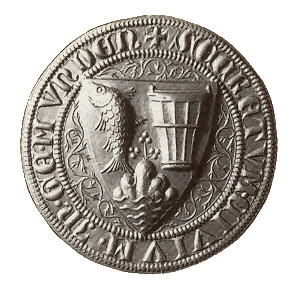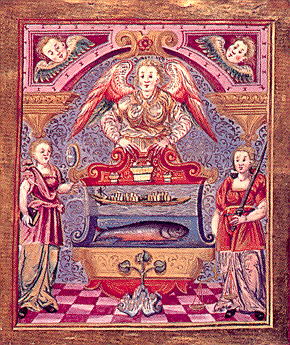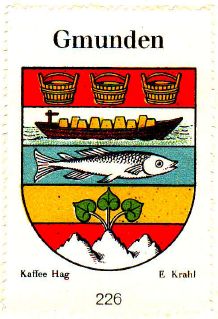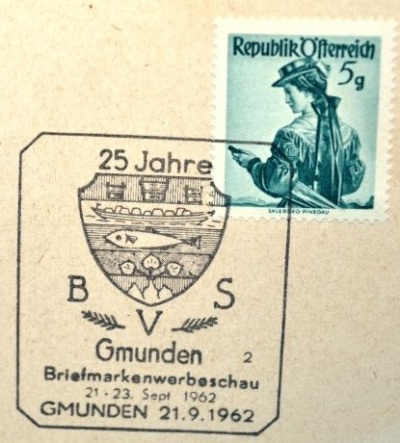Gmunden: Difference between revisions
Knorrepoes (talk | contribs) No edit summary |
Knorrepoes (talk | contribs) |
||
| Line 15: | Line 15: | ||
On March 8, 1593 Emperor Rudolf II granted the above arms, which were based on the old arms, but with in the upper bar three salt buckets, on the second bar a salt transport ship, the fish in the third bar and on the lower bars the mountain and the plant, clearly characterised as a water lily. Behind the shield an angel was shown and two female figures were added as supporters. | On March 8, 1593 Emperor Rudolf II granted the above arms, which were based on the old arms, but with in the upper bar three salt buckets, on the second bar a salt transport ship, the fish in the third bar and on the lower bars the mountain and the plant, clearly characterised as a water lily. Behind the shield an angel was shown and two female figures were added as supporters. | ||
In the late 18<sup>th</sup> century the angel and supporters were replaced by the Imperial eagle, which held the arms as a breast-shield. Later the eagle was removed and the arms have been used since.The mountain and water lily refer to the Traunstein mountain and Traunsee lake. The city was an important city for salt trading, hence the bucket and ship. The fish (officially described as a trout | In the late 18<sup>th</sup> century the angel and supporters were replaced by the Imperial eagle, which held the arms as a breast-shield. Later the eagle was removed and the arms have been used since.The mountain and water lily refer to the Traunstein mountain and Traunsee lake. The city was an important city for salt trading, hence the bucket and ship. The fish (officially described as a trout ''Salmo alpinus salvelinus'') symbolises the importance of fishing for the local economy. | ||
{|align="center" | {|align="center" | ||
Revision as of 10:36, 24 February 2018
GMUNDEN
State : Oberösterreich
District : Gmunden
Official blazon
Origin/meaning
Gmunden received the right to have its own seal in a document issued by Duke Rudolf III on May 4, 1301. However, there is some doubt about the authenticity of the document. In any case the oldest known seal of the city dates from 1354. The seal shows the arms used at the time, with in the base a mountain rising from the waves, and in the upper part a fish and a salt bucket. On the mountain is a small flower (see below). The oldest coloured image dates from 1503.
On March 8, 1593 Emperor Rudolf II granted the above arms, which were based on the old arms, but with in the upper bar three salt buckets, on the second bar a salt transport ship, the fish in the third bar and on the lower bars the mountain and the plant, clearly characterised as a water lily. Behind the shield an angel was shown and two female figures were added as supporters.
In the late 18th century the angel and supporters were replaced by the Imperial eagle, which held the arms as a breast-shield. Later the eagle was removed and the arms have been used since.The mountain and water lily refer to the Traunstein mountain and Traunsee lake. The city was an important city for salt trading, hence the bucket and ship. The fish (officially described as a trout Salmo alpinus salvelinus) symbolises the importance of fishing for the local economy.
| The seal of 1354 |
The image from the original document from 1593 |
| The arms in the Coffee Hag album +/- 1932 |
Special postal cancellation 1962 |
| Special postal cancellation 2014 |
Contact and Support
Partners:
Your logo here ?
Contact us
© since 1995, Heraldry of the World, Ralf Hartemink 
Index of the site
Literature : Baumert, H.E. : Oberösterreichische Gemeindewappen, Linz, 1996.

















